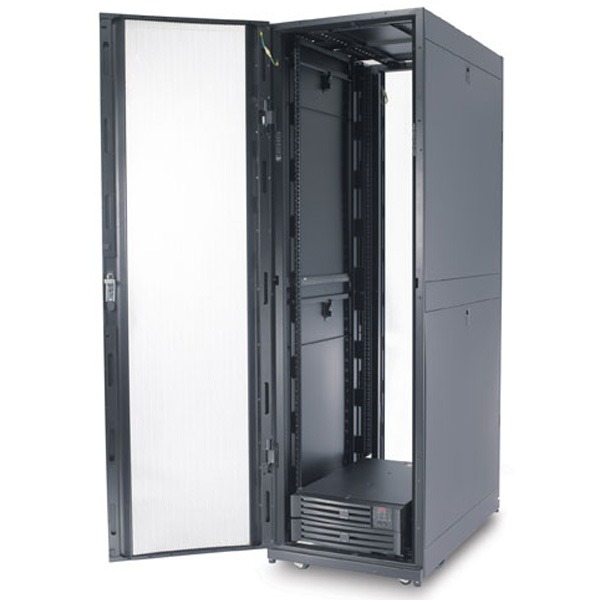
Equipping your server room with the right racks is crucial for organisation and airflow. This guide explores the key considerations for selecting and installing server racks, ensuring optimal performance and efficiency.
Key Takeaways:
- Choose a cool, secure location with ample airflow for your server room.
- Select a rack that accommodates your current needs and future growth.
- Employ proper labeling and cable management for easy maintenance.
- Ensure sufficient power distribution and backup with a PDU and UPS.
Q: What are the key considerations for installing server racks?
A: Choosing the right location, rack size, and cable management is crucial for optimal server room performance and efficiency. Consider factors like cooling, security, airflow, scalability, and power distribution when making your selections.
Server racks are an indispensable part of any data centre set up. But whether you are a smaller business with just one rack or a large company with dozens, it’s vitally important that you plan the installation of your racks carefully. This not only serves to ensure that things run smoothly now but helps to future-proof your investment in technology too.
In determining how to install server rack, you need to take a number of things into consideration. These include the physical location and the requirements such as cooling and power that go with it, together with the type of rack, and the cabling.
1. Choosing A Site
The first step is to decide where your rack is going to go.
In large data centres, this isn’t so much of a problem. You should already have a system which helps determine where server racks need to go.
In small and medium businesses, however, you need to select an appropriate room. Servers will usually contain sensitive company data, so under GDPR, a lockable door with minimum access is a must. It’s also a good idea to choose a windowless room. If this isn’t possible to install frosted glass so that no one can see in.
Servers tend to generate noise and heat, so your server room isn’t going to be a workable office environment. You may wish to provide a desk and chair for technicians when need to access the systems, but you can’t expect people to work in there all the time. This also reduces the risk of accidental knocks and spillages damaging equipment.
We’ve already mentioned heat, and depending on the size of your installation, you may need a strategy to cope with this. At the very least, this may mean an extractor fan, but for larger installations, you will have to look seriously at installing or upgrading air conditioning.
2. Choosing A Rack
Most server racks will be in the form of floor-standing cabinets. Some makes have doors on the front and back of the racks for additional security. Whether the cabinet needs to be lockable will depend on who has access to the room in which the server is located.
The rack doors will usually be made from types of material which allows air to pass through.
The best-known manufacturers of server racks are APC, Datacel and Prism. Choosing a high-quality server rack vendor will be of vital importance, as these racks will house vital equipment.
Choosing the size of server rack you require will be down to how much equipment you need to put in it. Remember that this isn’t just the servers themselves; you need to allow space for switches, comms equipment and perhaps a telephone system too.
Don’t restrict yourself by choosing a cabinet that is just big enough for your current needs. Always allow room for expansion. Your cabinet may seem too big now but you may be surprised how quickly it fills up as your business starts to grow.
Compatibility with your equipment is important too. Make sure that your rack is fitted with rails that are suitable for your equipment. Standard widths are generally 600 and 800mm so again check your requirements carefully.
Think about how you are going to get the rack into the room. Will it be too big to go through the doorway? A flat pack may be the answer in these circumstances.
3. Check The Temperature
As we mentioned earlier, servers can get really hot. The more technology you have, the hotter your room will become.
Hot temperatures are terrible for server equipment. The head can shorten the lifespans of products, and cause some equipment to turn itself off. While server racks are designed to keep air circulating, it isn’t enough on its own.
Ideally, you should have air conditioning in your server room, and it should be as cold as you can make it. Your air conditioning unit will need to remain on for the whole time your server is switched on. So, if your building’s air conditioning turns off when everyone has gone home, you will need to look into a standalone system.
4. Cabling
Finally, you can turn your attention to cabling within the rack. There are some key points here.
- Make sure that each cable is labelled at both ends.
- Ensure that you keep everything neat and tidy.
- Colour code your wires for quick visual prompts (e.g. for voice and data)
Cable management systems are available for most rack systems and you can use these to neatly route cables around the edges. This not only looks smart and professional but it makes troubleshooting easier in future.
5. Picking A PDU
Power distribution units (PDU) help protect your servers from surges of electric current. They help balance power to all the devices within your server. Buying a PDU needs to be considered carefully:
- Check which size you need for your server rack, as PDUs can vary in sizes
- Decide if you need a horizontal PDU or Vertical PDU for your server rack
- Work out how many outlets you need now, and how many you might need in the future.
- Decide if you want a basic monitored or another type of PDU.
6. Choosing A UPS
You will also need to consider getting an Uninterruptable Power Supply (UPS). If your server is mission-critical then a high-quality UPS is a must.
A UPS protects your network in case of a power failure. These are a short-term fix that keeps the server running for a small amount of time. These are particularly useful for businesses where the backup generator can take a little time to kick in.
